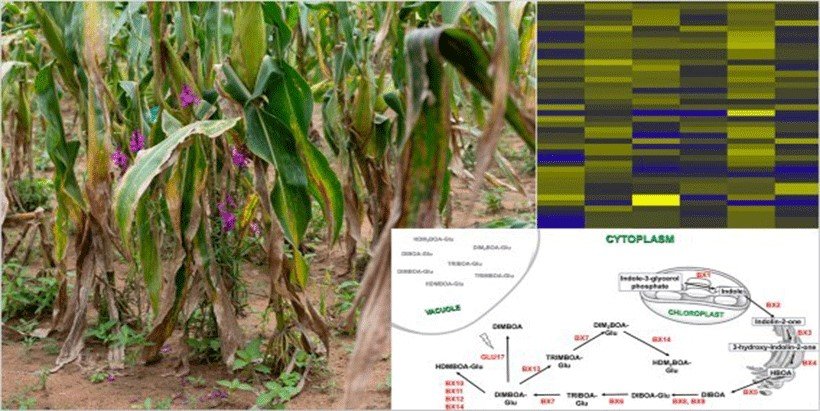Striga-infested maize plants, benzoxazinoid biosynthetic pathway, and heatmap of target gene expression. Photo Credit: IITA
By Livia Stavolone, IITA November 21, 2023, The International Institute of Tropical Agriculture (IITA–CGIAR) scientists have discovered remarkable resistance mechanisms that promise to improve crop protection from Striga infestation in Africa and enhance maize production across the continent.
In a recent study researchers found a previously unknown defense strategy based on the accumulation of a secondary metabolite called DIMBOA—a benzoxazinoid—that contributes to blocking Striga invasion of the maize root vascular system.
Striga hermonthica is an invasive parasitic weed entering host plant roots and forming direct vascular connections to the host vascular system, thus withdrawing water and nutrients. Despite its beautiful purple-colored flowers, it is commonly named witchweed to reflect the dramatic effect produced on maize and other major crops, seeming to magically arrest host growth and destroy yield, potentially up to 100%. This nutrient-sucking parasite thrives in poor soils with low rainfall conditions and farming systems using minimal or no fertilizer and poor crop management practices.
IITA maize breeders have selected a few sources of crop resistance originating from the maize wild relative Zea diploperennis, conferring partial resistance after Striga germination. In a collaborative effort, IITA molecular biologists, bioinformaticians, and breeders led by Livia Stavolone, Andreas Gisel, Abebe Menkir, and Melaku Gedil have investigated the biological mechanisms exploited by striga-resistant maize plants to defend from the parasite.
They demonstrated that the accumulation of DIMBOA, a benzoxazinoid with inhibitory and toxic effects against a wide range of pests, pathogens, and competing plant species, contributes to blocking Striga invasion of the maize root vascular system. DIMBOA is produced by specific plant families, particularly grasses, from which it can be extracted and purified, and is therefore commercially available.
On the way forward to sustainable and durable Striga control in sub-Saharan Africa, this discovery is not only key to breeding and engineering resistant maize plants, it also has potential future applications for direct control in the field.
Mature Striga plants leave tens of thousands of tiny seeds in the soil, where they can survive for years, ready to infest the maize plant triggered by maize germination. The potency of DIMBOA released from residues of plant cultivations and used for weed control opens future applications to reduce parasitic seed banks in the soil and parasite plant emergence in the field.
This article was originally published on the IITA website.







